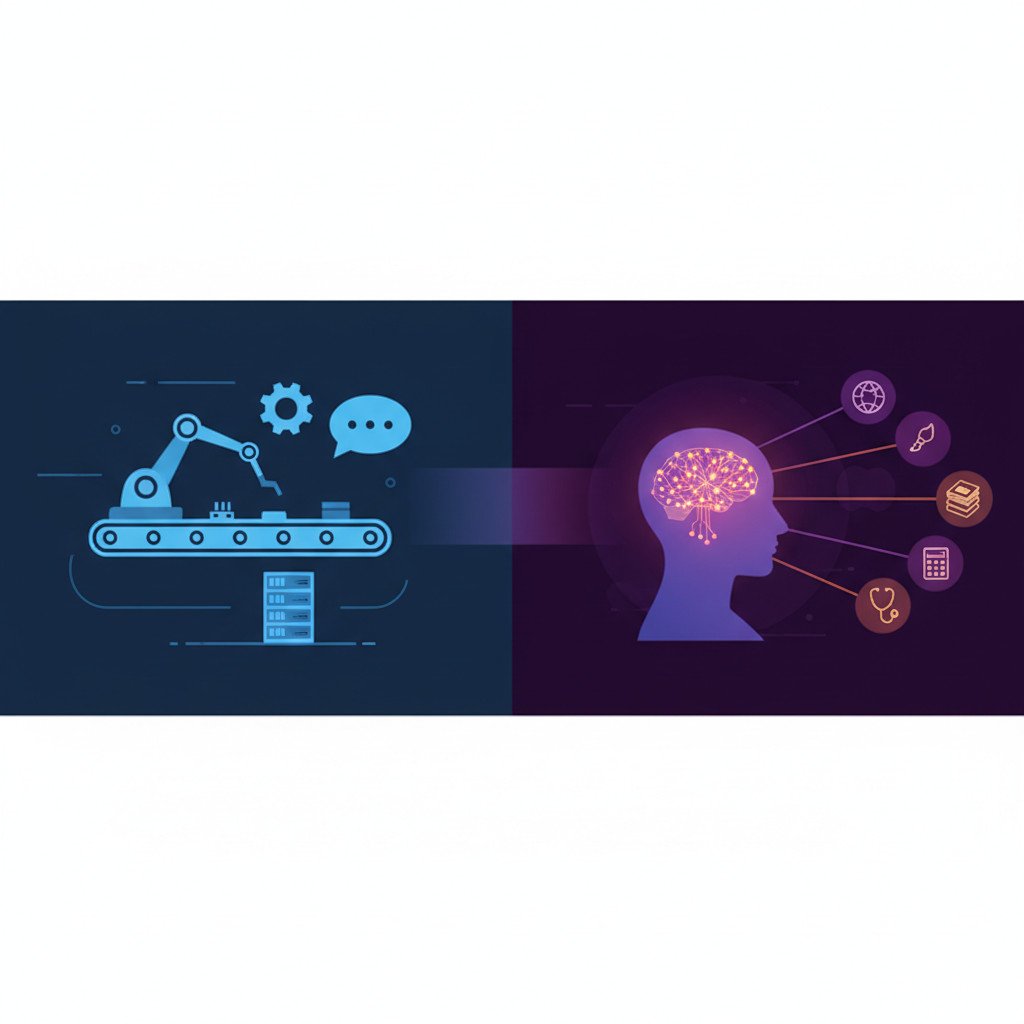AI vs AGI: readiness, adoption, and market hype
AI vs AGI: readiness, adoption, and market hype sits at the crossroads of reality and imagination. In short, AI refers to systems that solve narrow tasks like recommendation engines and chatbots. AGI refers to a hypothetical system that matches human versatility across many domains. Because their capabilities differ, so do how organisations prepare and adopt them.
Today, readiness varies widely. Some firms move quickly from pilots to production and scale infrastructure. Others lack GPUs, governance, or clear roadmaps, so projects stall. Meanwhile, adoption focuses on practical AI agents, automation, and efficiency gains rather than chasing general intelligence. Investors and media add another layer. As a result, market hype can inflate expectations, lift valuations, and create bubble risks. This article will unpack the practical differences, assess current readiness, and separate durable adoption trends from fleeting hype. Along the way, you will find actionable takeaways leaders can use to build real AI value.
Readiness: AI vs AGI: readiness, adoption, and market hype
Readiness measures an organisation’s ability to deploy, scale, and govern intelligent systems. For narrow AI this means clean data, GPUs, pipelines, and staff who can ship models. For AGI readiness it means sustained exascale compute, tightly controlled testing, and robust safety frameworks. Because AGI remains speculative, readiness focuses more on research, safety labs, and policy than on rollouts.
Progress so far looks uneven. Cisco found only 13 percent of organisations fully prepared for AI workloads, because many lack infrastructure and governance. See Cisco’s AI Readiness Index for details: Cisco’s AI Readiness Index. In contrast, AGI efforts show rapid research milestones, but no deployed, general systems. Teams at leading labs invest in massive compute clusters and simulated environments to test learning across domains.
Concrete examples help. Picture server rooms humming with GPUs, racks bathed in cold blue light, while engineers tune training runs. Picture customer service chatbots automating ticket triage in production. These are narrow AI wins. Now picture an isolated safety lab running multiagent tests for months. That scene represents early AGI preparation.
Key milestones and challenges
- Milestones
- Pacesetters moved pilots into production four times more often.
- Widespread plans to deploy AI agents suggest broad adoption soon.
- Increased safety research and governance frameworks at major labs
- Challenges
- Limited GPU capacity restricts many projects, with only about 25 percent able to meet requirements.
- AI infrastructure debt slows scaling and adds hidden costs.
- Governance, security, and workforce gaps leave many unprepared.
For further perspective on equitably scaling AGI research see this inbound piece: Democratizing AGI vs AI. For cautionary investor remarks from industry leaders, review Sam Altman’s warning: Sam Altman’s warning.

Adoption Trends: AI vs AGI: readiness, adoption, and market hype
Adoption of narrow AI has moved fastest where clear business value exists. For example, many firms deploy AI agents for customer service, automation, and analytics. Cisco reports that pacesetters move pilots into production far more often, and they design networks to scale for AI workloads. See Cisco’s AI Readiness Index for details: Cisco’s AI Readiness Index. However, AGI remains mostly a research ambition, not a commercial product.
Market hype amplifies adoption cycles. When investors and media spotlight AI, companies race to announce initiatives. As a result, perception often outpaces capability. For instance, surveys show rising concern that AI stocks may be overvalued. Industry leaders warn that some investors could lose money during corrections. See commentary on investor risk: commentary on investor risk and reporting on market fragility: reporting on market fragility.
Scenarios showing hype versus realistic adoption
- Best case
- Firms with clear roadmaps and infrastructure move from pilot to value quickly.
- Pacesetters capture profit and productivity gains because they scale properly.
- Hype-driven case
- Firms rush projects without GPUs or governance.
- Projects stall, creating wasted spend and reputational risk.
Mini case study
A mid-size retailer deployed AI agents for order tracking and returns. Within months, average response times fell and human agents focused on complex queries. Meanwhile, a venture-backed startup raised funds to chase broad AGI claims. Months later it had prototypes but no scalable product. The contrast shows practical adoption wins now, while AGI promises shape investment and expectations.
In short, adoption follows practicality. Meanwhile, hype shapes funding and public perception. Therefore leaders should prioritise readiness, measure outcomes, and avoid chasing headlines.
Quick comparison: AI vs AGI — key dimensions
| Dimension | Narrow AI | AGI |
|---|---|---|
| Definition | Systems trained for specific tasks. | Hypothetical general-purpose intelligence across domains. |
| Capabilities | High accuracy on narrow problems; optimized pipelines. | Broad reasoning, learning, and transfer across tasks. |
| Current usage | Production chatbots, recommendation engines, automation. | Mostly research prototypes and safety labs. |
| Readiness level | Moderate; 13% fully prepared globally; pacesetters lead. | Low practical readiness; focused on research infrastructure and safety. |
| Adoption scale | Rapid in enterprises with clear ROI and infrastructure. | Minimal commercial adoption; speculative and experimental. |
| Market hype | Strong media and investor attention; possible valuation bubbles. | Very high speculative hype; drives investments and policy debates. |
| Future prospects | Continued expansion across industries; measurable value. | Uncertain timeline; high impact if achieved but many unknowns. |
| Typical examples | ChatGPT, recommendation systems, AI agents in customer service. | Research labs running multiagent and transfer learning experiments. |
| Key risks | Infrastructure debt, governance gaps, biased models. | Safety, control, misaligned incentives, concentrated compute needs. |
Conclusion
AI delivers measurable value today while AGI remains a high-stakes research frontier. Pacesetters convert pilots to production and realise clear gains. However, many organisations lack GPUs, governance, or roadmaps and remain behind. Meanwhile, market hype inflates expectations and shapes funding cycles. As a result, leaders must separate durable adoption from speculative promise.
EMP0 is a US-based company that helps businesses apply practical AI now. The firm focuses on sales and marketing automation and builds ready-made AI tools and automation workflows. Therefore teams can deploy AI agents faster and scale revenue systems with less friction. Because EMP0 provides end-to-end automation, organisations can move from experiment to measurable growth.
If you want to explore practical paths forward, start with readiness. Measure infrastructure, secure governance, and prioritise use cases with clear ROI. For hands-on solutions, visit EMP0’s website and resources: EMP0’s website and the company blog at the company blog. Also check EMP0’s automation creator profile: EMP0’s automation creator profile. In short, focus on readiness, avoid hype, and build AI systems that deliver real value.
Frequently Asked Questions (FAQs)
What is the core difference between AI and AGI?
In the AI vs AGI: readiness, adoption, and market hype debate, narrow AI solves specific tasks. For example, recommendation engines and chatbots work within set limits. AGI would match human versatility across many domains. However, AGI remains hypothetical and mostly in research labs. Therefore businesses should treat current AI as practical and AGI as speculative.
How ready are organisations to adopt AI and AGI?
Readiness varies widely. For narrow AI some firms are production-ready, while most lack GPU capacity and governance. Cisco found only 13 percent fully prepared. For AGI readiness, groups focus on compute, safety, and policy rather than rollouts. In short, narrow AI readiness is real. AGI readiness is research focused and uncertain. See Cisco for more: Cisco.
How does market hype affect adoption and perception?
Hype accelerates announcements and funding. As a result, perception often outpaces capability. Some firms chase headlines and then stall. Meanwhile investors may overprice AI stocks, raising bubble risks. For investor cautions, read industry commentary: industry commentary.
What should business leaders prioritise now?
Prioritise readiness and ROI. First, measure infrastructure and governance. Second, pick use cases with clear value. Third, build skills and guardrails. By doing this, leaders convert pilots into production and capture measurable gains.
Should companies and investors treat AGI as an immediate commercial target?
No. AGI deserves research and policy attention. However, firms should not pivot core budgets to chase AGI now. Instead, invest in narrow AI capabilities that deliver near-term revenue and productivity.

